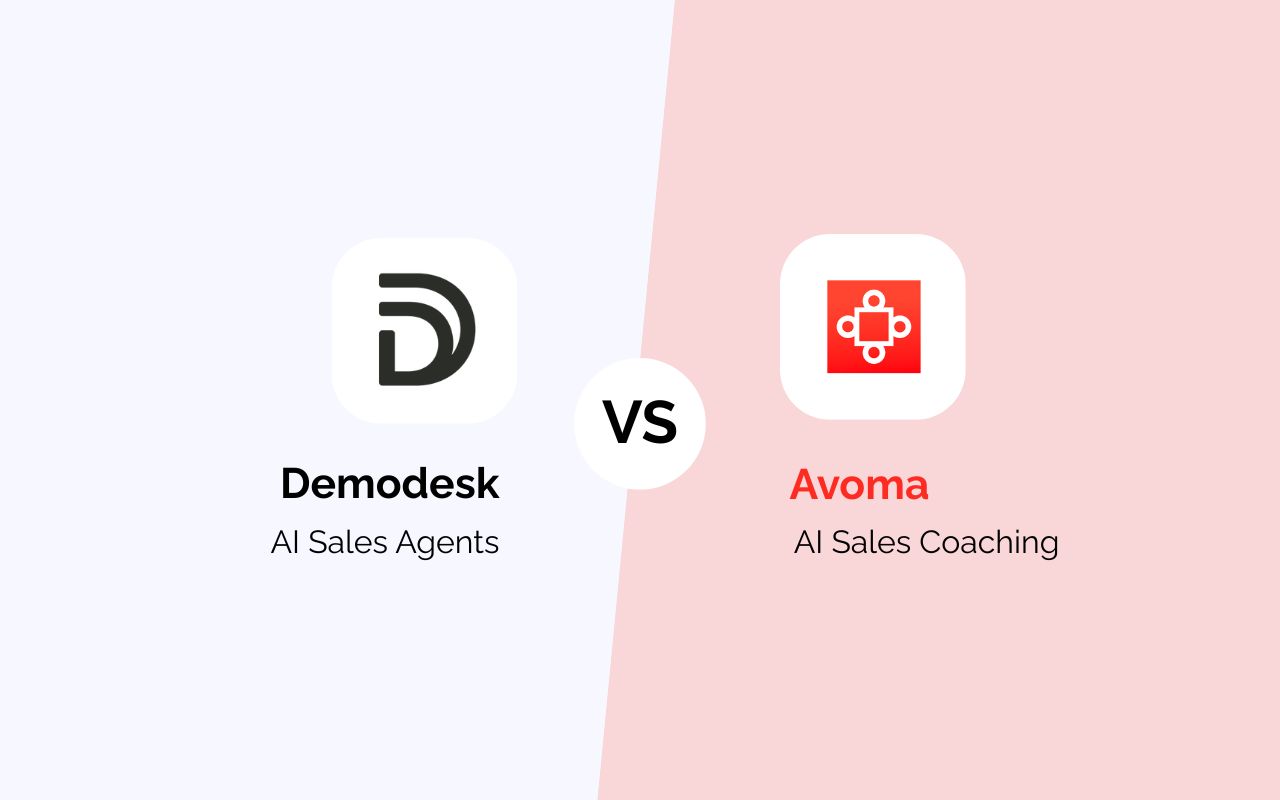Are you searching for AI note takers that can actually help your sales team improve performance? Many companies face this challenge. In today’s fast-paced digital sales environment, choosing the right AI meeting assistant, one that truly supports sales workflows, can make all the difference between simply recording conversations and driving real revenue outcomes.
Demodesk and Fathom are two recognized AI note-taking tools, yet they serve very different purposes. Fathom focuses on AI-powered transcription and summaries, helping teams document and recall meetings efficiently. Demodesk, however, was designed from the ground up for sales. Combining note-taking with sales-specific workflows, CRM automation, and AI coaching built on frameworks like SPICED and MEDDIC.
Your choice between these two tools will determine whether your team gains just another meeting recorder or a revenue intelligence platform that enhances your entire go-to-market process.
This comparison explores how Demodesk and Fathom measure up in four critical areas: core capabilities, sales workflow alignment, coaching and automation depth, and user feedback.
Scoring Methodology
We applied the 0–1–2 evaluation across seven GTM-critical domains:
- 2 points — Best-in-class
- 1 point — Functional but limited
- 0 points — Missing or underdeveloped
Overall Score Summary
Real-World Performance: What Sales Teams Are Actually Experiencing
When evaluating AI meeting assistants, understanding how features perform in practice, not just on paper, is crucial for sales teams and revenue leaders.
Fathom's Promise vs. Reality
Fathom positions itself with compelling value propositions for sales teams: automated action items, CRM integration, and AI-powered meeting intelligence, delivered through features like "Ask Fathom." But do these features deliver consistently?
What Works Well:
Sales teams report that Fathom's integration with platforms like HubSpot has improved forecast accuracy and communication between sales teams and leadership, providing better pipeline clarity. Transcription accuracy typically ranges from 90-95% with built-in microphones and light accents, and users particularly love the "Ask Fathom" feature, describing it as a "game changer" for querying meeting content with questions like "What were the top three reasons a prospect wouldn't move forward?"
Where Fathom Falls Short:
The most significant pain point? CRM integration reliability. Multiple users have reported recurring issues with CRM syncing, with one noting that after 16 emails over a week and a half, their sync problems remained unresolved. For sales teams whose workflows depend on accurate, automatic CRM updates, these reliability issues can be dealbreakers.
Transcription accuracy also degrades when language switches during calls, when strong accents are present, or when multiple speakers talk simultaneously. Additionally, Ask Fathom's search history isn't saved—once you exit the call recording view, your previous queries are lost, forcing users to repeat searches and reducing efficiency.
The Demodesk Advantage
Where Fathom struggles with consistency, Demodesk delivers enterprise-grade reliability. With 99% CRM accuracy, Demodesk eliminates the sync issues that plague sales teams using Fathom. Meeting notes, action items, and call insights flow seamlessly into your CRM without the frustration of failed syncs or support tickets.
Transcription accuracy is consistent and reliable across accents, languages, and meeting scenarios. No degradation when multiple speakers are involved or when conversations switch between languages.
The AI assistant experience is also superior: unlike Fathom's Ask feature, Demodesk saves your AI chat history both within transcripts and when using the AI analyst. You can return to previous insights, build on past queries, and maintain context across your entire sales process, not just individual meetings.
1. Conversation Capture & Understanding
➡️ Key Difference: Demodesk’s multilingual, GDPR-native engine makes it ideal for European GTM teams, while Fathom’s English-first model limits global deployment.
2. AI Actions & Follow-Up
➡️ Key Difference: Fathom delivers summaries, Demodesk executes follow-ups and CRM updates automatically.
Fathom connects with major CRM systems like Salesforce and HubSpot, but users often report integration challenges. One HubSpot Marketplace reviewer mentioned, “I wish the tasks it creates in HubSpot were more accurate.” Teams that rely on detailed CRM synchronization or custom object tracking often resort to manual workarounds to maintain data consistency.
Demodesk, on the other hand, achieves 99% accuracy in CRM data filling. Its AI Sales Agents automatically detect leads, opportunities, and custom fields, updating them in real time with zero manual input. This ensures every deal, contact, and follow-up is captured and synced flawlessly across Salesforce, HubSpot, and Pipedrive.
3. Coaching & Performance Optimization
➡️ Key Difference: Demodesk’s AI Scorecards are sales-specific and methodology-driven. Coaching reps on discovery questions, value alignment, and next steps. Fathom’s scorecards are generic and not tied to sales frameworks.
Fathom takes a post-call analysis approach with its AI Scorecards, which, according to the company’s documentation, are designed to “help leaders support their teams more effectively.” In practice, however, user feedback suggests that these scorecards remain pretty basic. Managers can label team members as Top Performers or Lower Performers, but the system doesn’t provide meaningful, AI-driven guidance on how lower performers can improve.
Demodesk, on the other hand, takes coaching a step further. Its AI Scorecards don’t just rate performance: they analyze calls using proven frameworks like SPICED and MEDDIC, and automatically generate AI suggestions for lower-performing reps based on the behaviors and techniques of top performers. This turns performance feedback into actionable coaching insights, something Fathom’s generic scoring system cannot yet achieve.
4. Pipeline & Revenue Intelligence
➡️ Key Difference: While Fathom has most features, Demodesk has developed them with more depth and accuracy. Making sure they are revenue oriented.
5. CRM Automation & Data Accuracy
➡️ Key Difference: Demodesk has specialized the AI to recognize objections and help reps overcome them to outperform their previous calls over and over again.
6. Integrations & Connectivity
➡️ Key Difference: Demodesk integrates to automate sales workflows, while Fathom needs Zapier or custom set-ups to integrate your workflow.
7. Security & Administration
➡️ Key Difference: Demodesk is built for Europe: with GDPR compliance by design and localized language models for EMEA teams.
Where Fathom Excels
- Easy setup and intuitive interface for meeting recording and summaries
- Basic AI scorecards for general meeting feedback
- Affordable entry for teams seeking lightweight note capture
Where Demodesk Leads
- Sales-specific AI Scorecards ( SPICED, MEDDIC, BANT ) for coaching and performance
- Full multilingual support — 98 languages, perfect for European teams
- Agentic AI Automation — CRM updates, follow-ups, deal insights done automatically
- Revenue Intelligence dashboards — turning conversations into pipeline visibility
- Zero-setup CRM integration — connect Salesforce or HubSpot instantly
- Privacy-first architecture — GDPR compliance by design
What This Means for Your Team
When Fathom's CRM sync fails and support takes weeks to resolve issues, revenue leaders lose visibility into pipeline health, and sales reps waste time manually updating records. When transcription accuracy drops below 85%, critical deal details get lost or misrepresented.
For sales teams where accuracy and reliability directly impact revenue, Demodesk's 99% CRM accuracy and consistent transcription performance aren't just nice-to-haves—they're essential. The platform delivers the meeting intelligence features modern sales teams need without the reliability concerns that have become common complaints among Fathom users.




.png)






